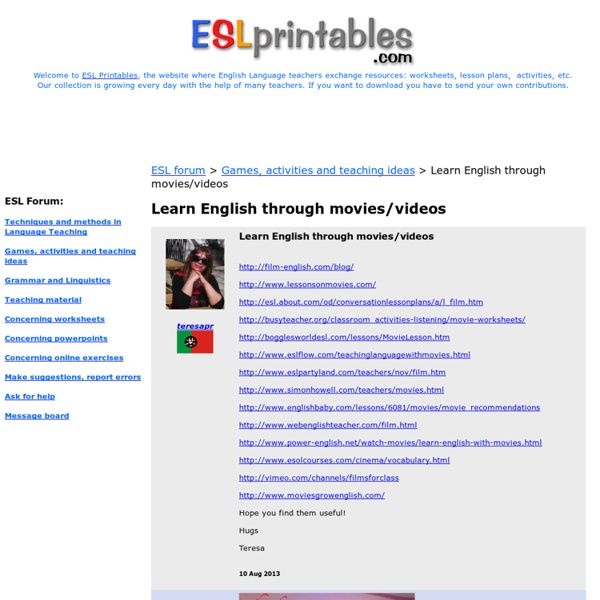



English in Gambier Vision off – YouTube technique Vision off – YouTube technique Submitted by admin on 5 July, 2011 - 08:42 This YouTube activity really gets your students thinking creatively. A short film is played for the students, but they can’t see the scene, they can only hear it. Students are motivated and have lots of fun. Preparation Open the YouTube video Teeth ( Procedure Tell students that you are going to play a short film (just over 2 minutes long) but they will not see it. ExtensionStudents can read the screenplays or storyboards and vote which one should be made into a film. Related link Scriptwriting Lesson: By Nicola Crowley Printer-friendly version listentoamovie.com English Day by Day Top 5 Sitcoms to Watch with your Students to Learn English The following is a list of top 5 TV shows that I believe are useful to helping students improve their English: 5. The Big Bang Theory The Big Bang Theory is currently one of the most popular sitcoms on TV. It’s about a group of nerds who all work at a University doing research and Science experiments. It’s a cleverly written comedic TV show. 4. The Wonder Years is an American classic television show that follows the life of Kevin Arnold through his teen years. This show really gives the students the feel of what life was like growing up in America during its golden era. 3. Why would Survivor make this list you may ask? The positive side of reality TV is that it isn’t scripted. 2. This is a very old BBC sitcom that I found accidently while surfing on YouTube. The students in his class come from all cultures and nationalities. 1. Not only do I believe that this is the greatest show of all time. Seinfeld actually uses very basic English in their scripts and is easy to understand. Related
Juno :: Películas En nuestra página web Cine para Estudiantes encontraréis las siguientes secciones: CICLO CINE PARA ESTUDIANTES (Área de Cataluña) Toda la información sobre las películas que hemos programado en salas de cine de Cataluña para el curso escolar actual: títulos, niveles educativos, áreas del currículum a las cuales se dirigen, poblaciones, fechas, salas, horarios y forma de inscribirse. Buscador de películas clasificadas por diferentes conceptos, enlaces de interés, noticias y para algunos filmes, propuestas de actividades didácticas. Nuestro catálogo de películas con propuestas de actividades para la clase, en diferentes lenguas y clasificadas por diferentes conceptos. SESIONES ESPECIALES (Área de Cataluña) Sesiones de cinefórum en el aula para el estudio y la reflexión sobre temas diversos a través de la proyección, el análisis y el comentario de fragmentos de películas. Información alrededor del mundo del cine, el lenguaje audiovisual y la enseñanza.
Exercice preterit 5eme Exercice preterit 5eme PDF Dimanche 13 Avril 2014 Vous n'arrivez pas à lire un fichier PDF?Cliquez ici PartagerMettez les fichiers PDF sur votre site <a href=' preterit 5eme</a> Autres PDF Parmi une banque de 18 millions de PDF Portable Document Format Le site Banque PDF est sur un domaine privé.
TED TALKS: “ONE SIZE FITS ALL” | ELT-CATION You are a good teacher. You work tirelessly to inspire creativity and motivation in your students. The list of bookmarked TED-videos in your computer is longer than the Great Wall of China. But you won’t have the time to design lesson plans with worksheets and handouts around these videos. If it is so, this post will come in handy. A TED talk’s title is usually snappy and sums up the idea of the talk. Write the title of the talk on the board (e.g. the recent talk I showed to my class – What Makes a Good Life. What Makes a Good Life Option A: Ask students to come up with ideas relevant to the topic. Option B: Or ask students to think of 9 (or 12) words/phrases that are relevant to the topic and that may be used by the speaker in the talk. e.g. Option C: While-Watching For Option A: get students to circle the ideas that are mentioned and add up new ideas. For Option B: get students to circle the words that are used. Nearly every talk has some statistics to support the message. Post-Watching